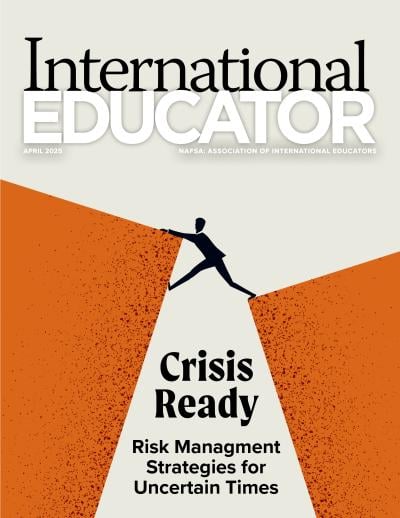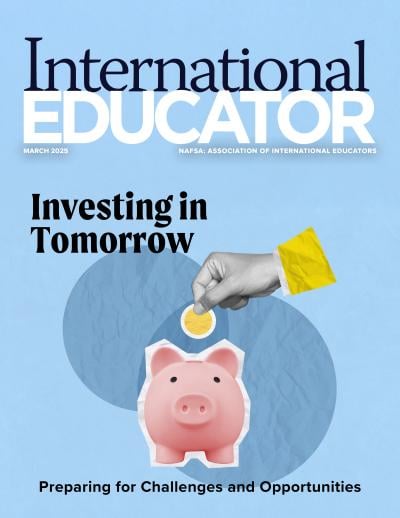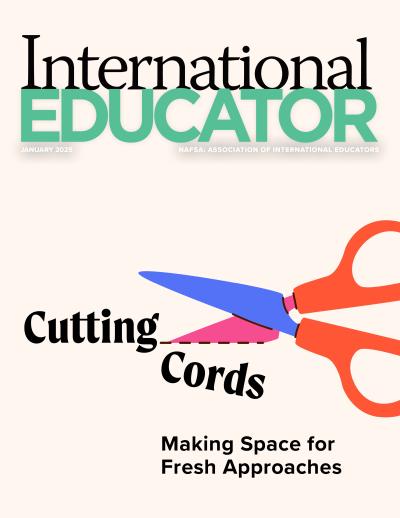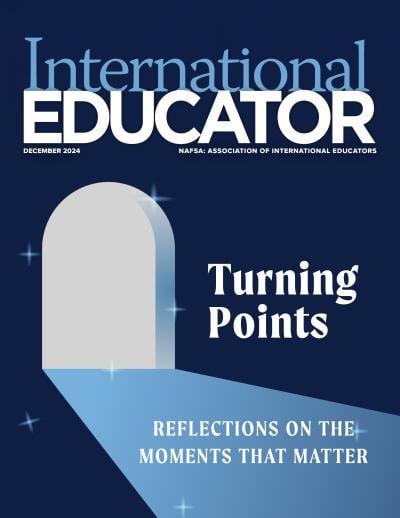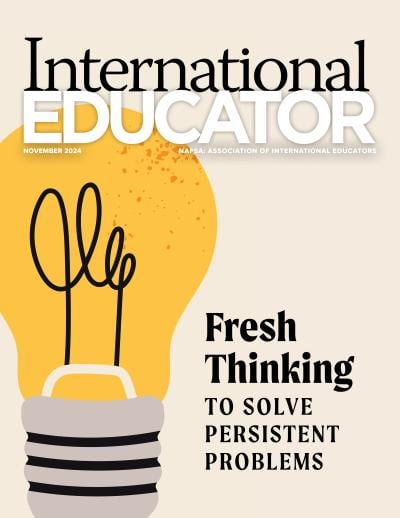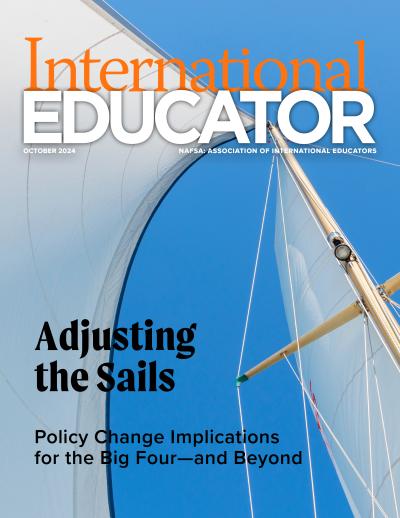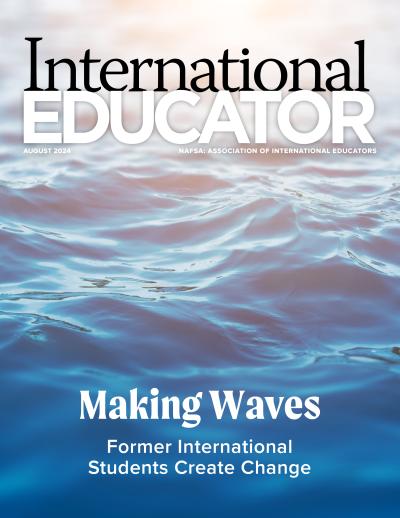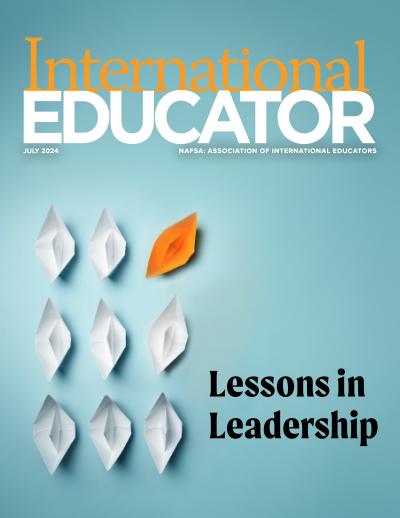International Education’s Role in Advancing the United Nations Sustainable Development Goals
The recently released Global Goals, Global Education: Advancing the United Nations Sustainable Development Goals serves as a practical guide for higher education institutions that want to build or strengthen their alignment with the United Nations Sustainable Development Goals (UN SDGs).
The book comes out at an important moment for both international education and the SDGs. With the 2030 deadline looming, there is much work to be done—and higher education has an important role to play. The chapters outline how sixteen institutions across the globe have successfully aligned different aspects of their work with the SDGs by:
integrating the SDGs into institutional goals and priorities;
advancing the SDGs through teaching and research; and
bridging global, regional, national, and local communities.
The excerpt below—which is from the book’s introduction—provides a framework for a holistic and intentional approach to higher education SDG engagement and a road map for institutions.
Editor’s note: The following has been edited and condensed for length.
The 2030 Agenda for Sustainable Development, with the 17 United Nations (UN) Sustainable Development Goals (SDGs), was adopted unanimously by every UN member state in 2015 (United Nations, n.d.-a). The international consensus around the SDGs creates a powerful shared commitment across the world, despite geographic, cultural, and historical differences. It also provides a shared vision for humanity and the planet. While this agenda is universal, at the same time, it is intended to support varying approaches that are driven by local and national priorities and needs.
The SDGs recognize that there are multiple actors, not just national governments, that must participate in achieving this shared vision. Higher education institutions (HEIs) play a central role in knowledge cocreation, research, innovation, and preparation of the next generation of leaders. All ranges and sizes of HEIs are important actors in achieving the SDGs. Some institutions may not be as visible or able to devote as many resources to the SDGs as others, but all types and sizes of institutions can make contributions—in fact, a diversity of institutional perspectives, strengths and experiences is essential to achieving these goals.
This is a critical time for HEIs to fully embrace and integrate the SDGs. As the 2023 Political Declaration of the High-Level Political Forum on Sustainable Development notes, “The achievement of the SDGs is in peril” (United Nations 2023, para. 8). Making real progress forward to address poverty, hunger, crisis, climate change, inequality, and the other challenges in the world will require the full commitment from HEIs and intentional actions on campuses, with local, regional, national, and international partners.
Overlapping Missions Between the SDGs and HEIs
The SDGs rest on core principles that align with the missions and priorities of many HEIs. First, the SDGs situate human and planetary challenges beyond environmental sustainability and within a holistic understanding of the three dimensions of social, economic, and environmental drivers. Because the SDGs cannot be addressed in isolation from one another, they require systems-level thinking and multi- and transdisciplinary approaches. Increasingly, HEIs are structuring research and teaching in more multidisciplinary ways. Integrating the SDGs into this work both supports and strengths these efforts.
Second, the 2030 Agenda emphasizes poverty as the “greatest global challenge” and asserts that eliminating poverty is a requirement for achieving sustainable development. At the heart of higher education is the opportunity to lift people out of poverty. The World Bank has highlighted evidence that shows a 9 percent increase in hourly earnings for every extra year of education globally. HEIs offer these opportunities to both youth and lifelong learners (World Bank 2023), and they play an essential role in solving the poverty challenge.
Third, the 2030 Agenda contains an explicit pledge by all countries that no one will be left behind. This has become known as the “leave no one behind” principle, and it threads through every one of the 17 SDGs. The agenda is also clearly anchored in human rights and gender equality principles, based on the Universal Declaration of Human Rights and other international commitments.
Many HEIs are building structures and processes to advance diversity, equity, inclusion, and belonging (DEIB) as well as social justice. Advancing the SDGs offers the opportunity to continue this work and to bridge internal, institutional silos and bring more of the campus community into DEIB efforts. For example, in the U.S. context, the SDGs can be used to bridge dialogue about DEIB in U.S. history and society with human rights, racial, ethnic, and gender equality challenges in other countries. This can be particularly helpful for engagement and belonging among international students and scholars, who may not otherwise feel included in U.S.-focused DEIB issues.
Finally, partnerships are the key mechanism to achieve the SDGs. Partnerships are a core part of the HEI mandate. They are a central aspect of effective research, teaching, and service. Many higher education institutions are focused on building partnerships and collaborations within academia and with other sectors and communities that can then be built upon to accelerate progress toward the SDGs.
A Starting Place for HEIs to Advance the SDGs
The good news is that there is growing interest and commitment on the part of HEIs around the world to advance the 2030 Agenda. Increasingly, HEIs are incorporating the SDGs in various ways into their core mission areas of teaching, research, and engagement. One of the key benefits of integrating the SDGs within HEIs is that the framework is flexible.
Contrary to some assumptions, advancing the 2030 Agenda does not require massive institutional investment and can be done in creative and innovative ways by leveraging existing institutional assets such as integration into curriculum, research collaborations, and student leadership initiatives on campus. The opportunities are boundless, but HEIs do need to act with intentionality in order to make meaningful contributions to this agenda.
The following sections outline ways for universities to examine the global higher education landscape; make strategic decisions about incorporating the SDGs into their efforts; and develop comprehensive, holistic, and intentional SDG strategies that address institutional priorities and contribute significantly to the advancement of the SDGs locally and globally.
1. Raise Awareness and Familiarity with the SDGs
Often, HEIs find it helpful to begin the process of intentional engagement with the SDGs through awareness-raising activities. These can be stand-alone events or programs or can highlight the SDGs within existing activities to bring attention to the relevance of current work to the Global Goals. Awareness raising can effectively convey the global significance of campus programs and accomplishments and can also inspire more involvement by members of the campus community.
Awareness-raising activities can also begin to clarify assumptions about terminology that often limit the understanding of the breadth of this agenda. Frequently, those who may have heard of the agenda but are not familiar with its content will assume that it is focused solely on environmental sustainability, and this narrow (and incorrect) interpretation shrinks the space for engagement. The rapid conflation between the terms “sustainable development” and “sustainability” has created additional confusion.
Another misconception is that “sustainable development” only applies to developing countries. The 2030 Agenda explicitly states that it is a commitment for every country in the world—including both developing and developed. Raising awareness about these elements of the SDGs is important to support broad engagement—and to involve many perspectives and areas of work—across campuses.
At Mount Kenya University (MKU) in Kenya, for example, all stakeholders on campus—including faculty and students—and the local community have been included in workshops, conferences, and events on the SDGs. As the university hub on SDG 10, Reducing Inequalities, for UN Academic Impact, MKU organizes activities to sensitize the campus and local community on different aspects of the SDGs, such as tree-planting days, national peace walks, campus conferences on peace and development, and celebrations of international days, such as World Environment Day and African Child Abled Differently.
2. Map University Activities to the SDGs
HEIs have taken many approaches to align existing work and track their contributions to the SDGs. Some institutions have decided to pursue global impact rankings to encourage data collection and compare their progress with that of other HEIs around the world. In some cases, HEIs have used this process as a way to raise awareness across different units on campus that may not have otherwise been engaged with the 2030 Agenda but that hold relevant data for the ranking submissions. Other HEIs have chosen to pursue voluntary university reviews (VURs), loosely modeled on voluntary national reviews (VNRs), which are encouraged at the international level for national governments to submit. Some HEIs have chosen to focus on particular SDGs for their VURs, while others have examined relevant activities across all 17 of the goals.
Carnegie Mellon University (CMU) in the United States produced the first VUR in the world in 2020, which was completed by a team of students, faculty, and staff. Since 2020, CMU has published annual VURs, expanding and evolving its process in response to the stated needs of the university community and partners, taking stock of progress, and informing plans for the coming year. An important value of this process for CMU is that it facilitates connections across work on the SDGs, and the process of mapping has led to and informed new SDG initiatives.
Some HEIs have examined ways to not only align their work with the 17 SDGs but also to connect their work with the 169 UN targets and indicators associated with the SDGs. Directly incorporating the framework associated with these targets—the Global Indicator Framework—into institutional efforts is not always possible. Because the framework is intended for governments, the majority of the targets do not fit with institutional or local contexts or operations. However, this framework can be used as a tool for students to learn the key topics within each SDG that the international community is focused on and to explore potential gaps in the data and analysis. HEIs can also utilize the targets and indicators to help inform research so that it supports measuring SDG progress in priority areas and can also create their own targets and indicators that more closely relate to their contexts and the nature of their work.
3. Integrate the SDGs into Institutional Strategy
Integrating the SDGs into the strategic goals and priorities of HEIs can send a powerful message of commitment toward the shared Global Goals, not only internally to all campus units but also externally to existing and potential partners as well as prospective students, faculty, and staff members.
One area where this is particularly helpful is in strategic planning and articulating the connection of the 2030 Agenda to institutional mission and vision in order to underscore an institution’s unique identity and strengths. Strategic planning efforts for the entire HEI, and for each unit, create an opportunity to reflect on these aspects of the campus and to embed global commitment principles (when possible, with a direct reference to the SDGs), into the documents that guide institutional plans and actions.
The University of California-Davis (UC Davis), for example, released its first campus global strategic plan in 2023 (UC Davis 2023). The plan explicitly articulates the university’s commitment to the SDGs. The strategy was developed by a committee with representatives from schools, colleges, and units across campus and included input from faculty across the university. The shared commitment toward the SDGs that emerged provides an important strategic foundation for fully integrating the 2030 Agenda into all global efforts across the campus.
As they identify their priorities, colleges and schools within HEIs can amplify their plans as they relate to the SDGs. Similarly, centers, institutes, research groups, and labs can openly define how their work connects with a particular SDG or a group of SDGs. Any financial awards made to faculty and students, such as grants or scholarships, can specify and recognize such commitments. The goal is to drive the institution’s commitment across all units and levels, so no unit is left out of the institutional-level commitment to the 2030 Agenda.
4. Support Champions of the SDGs
Often, there are pockets of high awareness about the SDGs on campuses, and those are the spaces where the SDGs are integrated in interesting ways in specific programs and initiatives. These efforts are initiated and promoted by individual champions who see their work as aligning closely with the 2030 Agenda. Champions are important at all levels, including staff, faculty, and students.
Champions in senior-leadership roles, for example, can bring visibility and harness resources to accelerate these efforts. When the University of Minnesota in the United States established its SDG Initiative, one of the first steps was to bring university leaders together for input. This engagement of diverse champions started the initiative with a collaborative foundation, supported awareness raising across campus, and ensured longer-term faculty engagement.
HEIs can also harness resources to seed SDG projects and support champions among all members of the campus community. For example, they can offer grants to faculty or researchers or credit-based learning opportunities to students. Institutions can also amplify the work of champions through awards for global or community engagement or public scholarship as well as through a variety of campus communication channels and storytelling. UC Davis, for example, recently created a new way for faculty to acknowledge the impact of their global work in the tenure and promotion process by inviting faculty to present in their dossier a statement on public and global impact.
5. Expand Knowledge Cocreation and Research
HEIs are centers of knowledge generation, and the knowledge that they produce is connected, in many instances, to the SDGs in visible and invisible ways. Amplifying these links and integrating the SDGs where they may not yet be included provides an opportunity to connect the process of research and discovery with shared challenges that are relevant both locally and globally.
One of the key actors for expanding research and discovery to advance the SDGs is faculty. Grant programs can support faculty and other researchers on campus in developing new collaborations with partners that focus on the SDGs or intentionally integrating the SDGs into existing collaborations. In addition, seed grant programs that promote international research can become a starting point for integrating the SDGs into research. The University of Cape Town in South Africa launched the Vision 2030 Grand Challenges Programme, which provides seed funding for four projects to stimulate research and ideas to address grand challenges in Africa. The university also supports postdoctoral research on the SDGs through a fellowship program.
HEIs can also expand the scope of knowledge creation to support the 2030 Agenda principles by recognizing, engaging, partnering, and elevating the voices of Indigenous, underserved, and marginalized communities. Equity in collaborations is an important element of sustainable development, which facilitates and strengthens participatory and multidisciplinary research activities.
In addition, HEIs can leverage their expertise in designing data collection and analysis efforts to better focus on vulnerable and marginalized communities. There continues to be a lack of data on progress—and backsliding—on the SDGs for these populations. HEIs can play an important role in starting to close that gap in data so that real progress is being measured, with a focus on leaving no one behind.
Engagement in the SDGs can also open new entry points for faculty, staff, and students to become involved in research and discovery with multiple partners through consortia and networks. There are several international networks that focus on university engagement with the SDGs, including the UN Sustainable Development Solutions Network, UN Academic Impact, the University Global Coalition, and the UN Higher Education Sustainability Initiative. These networks can lead to working groups or consortia of HEIs and other entities that can work together on deeper-dive projects that may focus on one or more SDGs specifically or a topic that crosses multiple SDGs.
6. Nurture Students’ Curiosity and Leadership Skills
The 2030 Agenda often resonates, in powerful and exciting ways, with HEI students. SDGs address students’ concerns while offering a framework to learn and analyze complex problems and their interconnections. The SDGs can be a tool for carrying out critical analysis, understanding complexities and trade-offs, examining power dynamics, and fostering full participation of all stakeholders in decision-making, all of which are valuable skills in any discipline or career path.
The SDGs can bring additional dimensions to existing global learning, DEI, and environmental sustainability programs that are offered to students. UC Davis, for one, is integrating the SDGs into programs that advance global learning and leadership development for all students, including graduate and postdoctoral students, through the Global Affairs Graduate and Postdoc Certificate Program, which focuses on improving networking and leadership skills for success in intercultural work environments.
Some HEIs have found it helpful to begin by mapping existing courses to the SDGs to better understand the landscape of curricula that addresses SDG topics. The University of Edinburgh in the United Kingdom completed a curriculum-mapping exercise to identify courses that were drawing upon the principles of one or more of the SDGs. Building on the mapping, the university reviewed the curriculum to decide how to integrate the SDGs within all courses in the university and to create stand-alone course offerings. Another approach is to incentivize and train faculty to integrate the SDGs into existing courses, as was done at the Tecnológico de Monterrey in Mexico, which has engaged with faculty in creating Collaborative Online International Learning (COIL) courses that integrate the SDGs.
The 2030 Agenda is also a framework that can be used to bridge local and global problems and solutions so that students can feel more empowered to make a difference. Through the UC Davis SDG Internship, for example, students plan outreach and dialogue with student clubs and student initiatives, conduct research and analysis of issues that affect the campus and local communities, and report on and share innovative approaches to the SDGs by members of the university. Through this program, SDG interns conceptualized and developed a UC Davis Student Guide to the SDGs, which includes various ways that students can get involved at the campus, local, and international levels.
7. Advance Partnerships on Campus
Advancing the SDGs also presents an opportunity for HEIs to connect across institutional silos, expand the lens on major priorities, and deepen partnerships with campus entities as well as external organizations. The diversity of expertise found in partnerships strengthens the intersectional and interdisciplinary approaches to the SDGs at HEIs. In some cases, SDG efforts are led by a specific campus unit, while in others, the initiatives are more decentralized and emerge from individual champions—often without as much institutional-level direction or support. Either way, it is important to make efforts to connect across units and partners so that the holistic and interconnected nature of the SDGs is reflected in campus priorities and activities.
The SDGs can support HEIs in overcoming silos through a variety of on-campus collaborations. On the teaching front, Shanghai Jiao Tong University (SJTU) in China, for example, established a campuswide initiative called the SDG July Camp, with the goal of promoting transdisciplinary teaching and learning on the SDGs. The initiative involved both academic and international offices across campus, with the recognition that the university needed to engage in collective efforts across disciplines and that it could provide a testing space for faculty to collaborate beyond their own disciplines. In terms of research, the University of Sydney in Australia leverages multidisciplinary partnerships to build an SDG research ecosystem across its campus. And Carnegie Mellon University in the United States established a Sustainability Studio as a physical space on the campus to connect and promote discussion and collaborating across disciplines and units in order to advance the university’s commitment to the SDGs.
Partnering across units is beneficial for stewarding limited resources while strengthening the quality of the work on these multifaceted and complex challenges and expanding opportunities to engage with diverse communities of practice.
8. Bridge Global and Local Efforts
Local communities and governments are addressing the SDGs through their own goals, policies, and programs. Yet, organizations and communities at the local levels often do not work with global frameworks, or they have limited awareness of the SDGs. Additionally, they rarely have access to engage in global dialogues and decisions. This is a missed opportunity to connect needs and solutions at the local level with shared global concerns and desire for good practices that could be adapted elsewhere. The SDGs offer an enormous opportunity for HEIs to begin to connect the local and global more intentionally, with a focus on promoting equality, human rights, and participation.
HEIs are collaborating at the city level to advance the SDGs in different ways, one of which is through expertise exchange and training. In some cases, cities are inviting faculty and researchers into the city administration to address specific problems that the city staff do not have the time or capacity to analyze. In others, universities are including local government representatives in their research efforts. HEIs have also highlighted an increasing demand for executive training for local government officials, which is an opportunity to integrate the SDGs. In addition, institutions are collaborating with local civil society initiatives, where the SDGs are embraced as a valuable framework for bringing together organizations addressing city and regional challenges.
Voluntary local reviews (VLRs) have emerged as one mechanism to align city- and municipality-level efforts with the Global Goals and are another opportunity for university and local collaboration (United Nations, n.d.-b). For example, the City of Los Angeles and several area universities have partnered to complete VLRs and to facilitate collaboration among city staff, faculty, and students through task forces that engage in research on such issues as poverty, climate change, homelessness, and gender equity (Morales et al. 2021).
In many cases, these types of local collaborations between campuses and communities lead to other opportunities for student and faculty engagement. In Los Angeles, for example, universities and the city have developed a task force model to structure policy research relevant to the SDGs for the city, translating the broad SDG goals to “hyperlocal” problems (Morales et al. 2021). Faculty serve as academic advisers who guide students in working directly with the city on specific topics.
HEIs are also expanding their engagement with the SDGs through regional and international collaborations. For example, the University of Osaka in Japan is actively involved in the planning of the 2025 World Expo in Osaka, which is intended to advance the SDGs under the theme “Designing Future Society for Our Lives.” Osaka University also is heavily involved in collaborative efforts in the Kansai region, including an initiative it launched called the Inochi Forum. This forum is intended to bring together input from local citizens and youth, local government, businesses, nongovernmental organizations, and HEIs to create a declaration on the SDGs that will be disseminated at the World Expo.
As these examples illustrate, there are numerous opportunities for HEIs to contribute to the SDGs depending on their contexts, resources, and level of commitment. The time is urgent, and all HEIs are positioned to help make the 2030 Agenda a reality. With leadership, champions, creativity, and intentionality, the higher education sector can lead in the transformation—for people, planet, and prosperity. •
References
Morales, Gaea, Erin Bromaghim, Angela Kim, Caroline Diamond, Alejo Maggini, Avery Rose Everhart, Sofia Gruskin, and Anthony Tirado Chase. 2021. “Classroom Walls and City Hall: Mobilizing Local Partnerships to Advance the Sustainable Development Agenda.” Sustainability 13 (11). https://doi.org/10.3390/su13116173.
UC Davis (University of California-Davis). 2023. “UC Davis Global Strategic Plan.” UC Davis Global Affairs (website). https://globalaffairs.ucdavis.edu/global-strategic-plan.
United Nations. n.d.-a. “The 17 Goals.” United Nations Department of Economic and Social Affairs (website). Accessed March 25, 2024. https://sdgs.un.org/goals.
———. n.d.-b. “SDG Localization and the Voluntary Local Reviews.” United Nations Department of Economic and Social Affairs (website). Accessed March 25, 2024. https://sdgs.un.org/topics/voluntary-local-reviews.
———. 2023. “Political Declaration of the High-Level Political Forum on Sustainable Development Convened under the Auspices of the General Assembly.” United Nations (website). https://documents.un.org/doc/undoc/gen/n23/306/65/pdf/n2330665.pdf?token=5tCKud30iflQ0GKRd7&fe=true.
World Bank. 2023. “Education: Overview.” World Bank (website). https://www.worldbank.org/en/topic/ education/overview.
NAFSA Resources
About International Educator
International Educator is NAFSA’s flagship publication and has been published continually since 1990. As a record of the association and the field of international education, IE includes articles on a variety of topics, trends, and issues facing NAFSA members and their work.
From in-depth features to interviews with thought leaders and columns tailored to NAFSA’s knowledge communities, IE provides must-read context and analysis to those working around the globe to advance international education and exchange.
About NAFSA
NAFSA: Association of International Educators is the world's largest nonprofit association dedicated to international education and exchange. NAFSA serves the needs of more than 10,000 members and international educators worldwide at more than 3,500 institutions, in over 150 countries.
NAFSA membership provides you with unmatched access to best-in-class programs, critical updates, and resources to professionalize your practice. Members gain unrivaled opportunities to partner with experienced international education leaders.





